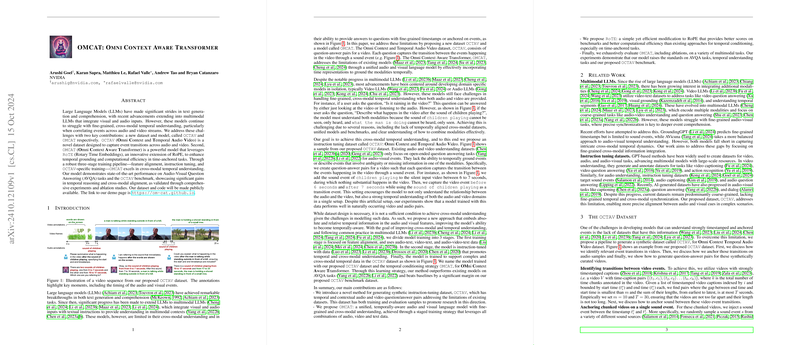Overview of OMCAT: Omni Context Aware Transformer
OMCAT, or Omni Context Aware Transformer, introduces a significant advancement in the field of multimodal LLMs by addressing challenges related to fine-grained, cross-modal temporal understanding. The research presented by Goel et al. highlights two primary contributions: the introduction of a novel dataset, OCTAV, and the development of the OMCAT model. This paper achieves a notable stride in enhancing cross-modal alignment, focusing specifically on the integration of audio and video inputs with improved temporal reasoning capabilities.
The core innovation of this work lies in the application of Rotary Time Embeddings (RoTE), an extension of RoPE, which optimizes temporal grounding and efficiency in tasks that require precise time-anchoring. The authors present a three-stage training pipeline—feature alignment, instruction tuning, and OCTAV-specific training—that enables OMCAT to achieve state-of-the-art results on complex tasks such as Audio-Visual Question Answering (AVQA).
OCTAV Dataset and Methodological Contributions
The newly proposed OCTAV dataset is designed to resolve the limitations of existing datasets by including temporally aligned audio and video event transitions. This dataset features question-answer pairs that emphasize the transitions between audio-visual events, thereby fostering a stronger understanding of temporal relationships. The OCTAV dataset stands out due to its comprehensive coverage, including modalities, timestamps, and multi-turn setups. These characteristics allow it to serve as an effective benchmark for assessing cross-modal temporal understanding across diverse scenarios.
OMCAT's approach involves a specialized model architecture that includes an audio-visual adaptor framework to map encoded features into a common text space. By integrating novel time alignment mechanisms—Interleaving Time Tokens (ITT) and RoTE—the model captures both absolute and relative temporal information, facilitating deeper synchronization across modalities.
Evaluation and Experimental Results
OMCAT demonstrates significant performance improvements on a variety of benchmarks. For instance, it surpasses existing models on the AVQA tasks and shows superior results on the OCTAV benchmark, validating its effectiveness in cross-modal temporal comprehension. As detailed in the paper, the OMCAT's enhancements are evident through comparative evaluations with other models such as GroundingGPT and Video LLaMA 2, where it outperforms baselines in terms of accuracy and recall metrics.
In experiments with the OCTAV-MT dataset, which features multi-turn dialogues, OMCAT shows marked improvements in scenarios with real-world, natural audio-visual events. The use of RoTE embeddings is particularly highlighted for its computational efficiency and precise cross-modal alignment capabilities.
Implications and Future Directions
The introduction of OMCAT and the OCTAV dataset opens pathways for further exploration in multimodal AI. Addressing fine-grained cross-modal synchronization offers vast implications for both theoretical research and practical applications, such as dialogue systems, real-time video analytics, and human-computer interaction.
Future work could focus on extending the dataset to include more complex and longer-duration events, thereby approximating real-world conditions more closely. Additionally, the incorporation of video encoders that better capture temporal dependencies may further enhance the model's applicability and performance across dynamic environments.
In summary, the OMCAT model makes significant strides in multimodal language processing, showcasing the potential of integrating advanced time embeddings for improved temporal reasoning. This work is poised to set new benchmarks in the field and inspire ongoing research into the challenges of temporal and cross-modal understanding in AI systems.
